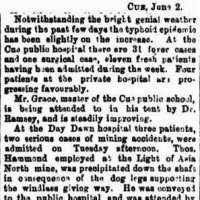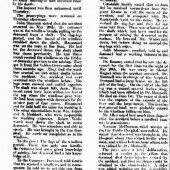Thomas HAMMOND
Age at Death35
Date Of Death4 June 1895
OccupationProspector
Name Of Mine On Which Last Employed
Light of Asia GM, Cue, Western Australia
Diagnosis or cause of accident
Windlass gave way and Hammond and the barrel fell down the shaft. Accident occurred on the 28 May and Hammond died in the Cue Hospital.
Place Of Burial
Cue and Day Dawn Cemetery, Western Australia
Submitted by
David McMillan and Eric Chamberlain
District
Cue
Cause of Death
Mine Accidents
Other Information
Hammond, Thomas. "Western Australian Lonely Graves & Burials at Sea Vol Two F-Mc. (2017) Coate, Yvonne & Kevin. Hesperian Press. Page 399.
The Light of Asia Mine was one of the more substantial on the field. It is found about one kilometre east of the highway, along the northern edge of Rifle Range Road at the northern end of the field.
There were four leases which were worked together being Light of Asia, Light of Asia North, Light of Asia South, and the Queen of the May which adjoined the leases to the east. Development work is first noted in 1895, when an English company, Murchison Consolidated Gold Mining Company, purchased it for 35 000 pounds along with eight other nearby leases. A 20 head battery was ordered, but only 10 heads were erected. One source states little work was done on the property and great sums of money were wasted. From 1897 to 1898 the mine was under exemption, while the company focused on its Cue One lease elsewhere on the field. The company eventually went into liquidation. Around 1899 the mine was taken over by the Cue Consolidated Gold Mining Ltd which owned other leases in the area. They abandoned the field in 1903, and took up speculative mining in West Africa which failed.
The mine had a poor safety record. The authorities at the time always deemed mine accidents an act of God, and while this remained, there was no impetus for mine owners to take safety of its employees seriously. In 1901, John Wishart was killed in a fall of earth at the Queen of the May mine. Russian Joseph Kominsky in 1918, and H. Tucker 1919, Italian Lorenzo Martini 1921 all in falls of earth at the Light of Asia mine. Kominsky had only been employed at the mine for a few days.
After Cue Consolidated abandoned the mine, it was taken over by Ned Lloyd, former manager of neighboring Gem of Cue Mine, who worked it profitably from the existing workings until his death in 1912. It appears the mine was then taken over by a local syndicate with Perth Lord Mayor F. Rea as principal shareholder. From 1913 to 1918 this syndicate took out 23 000 tonnes of ore at 18 dwt Au, and 20 000 in tailings at 4.5 dwt.
The Mine's office was broken into in May 1906. The safe was carried to a nearby area, buried in sand, and blown apart with dynamite. Edward Chainley and Charles Tinaley were arrested after being followed by aboriginal trackers. In their possession were three now damaged gold watches, some small slugs of gold, a few gold specimens, a masonic emblem, all belonging to Ned Lloyd. Also found was a stolen revolver and bicycle lamp.
In 1909, William Wells took the mine management, employees and the Miner's Union to court, claiming pressure had been placed to sack him as he was not willing to join the union. The matter reached the Supreme Court. It is useful as it listed the miners working at the time being E.E. Heitmann, T. Roscoe, R. Roscoe, C. Roscoe, J. Casey, B. Pratt, W. Corwine, J. McGrath, J. Hickey, W. McConnell, B. George, W. Meldrum, J. Hall, J. Lindsay, T. Brown, B. Smith, E. Fitzgerald and C. Wright.
In September 1918, the mine was taken over by Adelaide based Mararoa Company. This company was particularly active until 1922, when the mine was closed due to a lack of gold. Mararoa then switched its operations to the Emu leases at Reedy's, a goldfield north of the Cue district.



